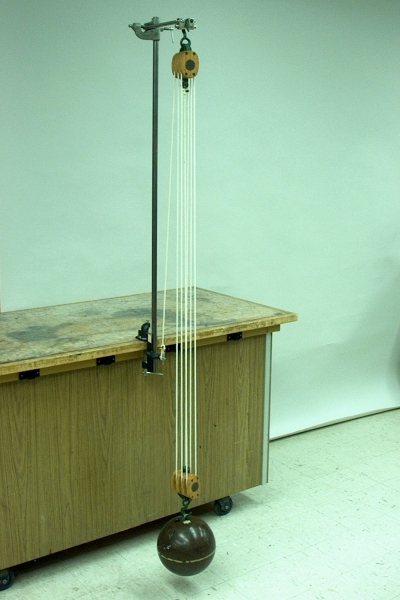

This pulley set consists of two triple pulley blocks. One end of the rope is tied to the staple on the bottom of the top set of pulleys, from where it loops around each pulley in each set, with the free end emerging from the last pulley on the top. The rope therefore passes over six pulleys, with six sections between the pulley blocks, and the free end coming out. So if you pull the free end out by a certain length, each section of rope between the blocks shortens by one-sixth of that length. That is, for each unit length you pull the rope, you raise the bowling ball by one-sixth that length. Because the tension is the same along the entire length of rope (otherwise one section should move relative to the others), the total tensive force between the pulley blocks is six times the tension you pull on the free end. The weight of the 7.3-kg bowling ball is 72 newtons, so the tension on the free end when it is anchored as shown in the photograph is 72/6, or 12 N. For simplicity, we will ignore the weight of the bottom pulley block itself, which adds slightly to the load.
The distance between the staples on the pulley blocks in the rig as shown is about 1.7 m, so by pulling the free end, you can lift the bowling ball by about this distance. To do so, you must pull the free end of the rope six times that length, or about 10 meters.
Neglecting friction, mostly rope drag due to the tendency of the pulley blocks to tilt somewhat as you pull the rope, this pulley system affords you a 6:1 mechanical advantage. The force you exert to lift the ball is just over one-sixth the weight of the ball (“just over”, because you have to accelerate the ball from rest), but to do so, you must pull six times the distance through which you lift the ball. Your effort, therefore, is one-sixth what it would be if you lifted the ball without the pulleys, but the work you do is the same. If you lift the ball through a height h, and the force exerted by the ropes is 6T, the work is (6T)h. The work you do on the free end of the rope, pulling tension, T, over a distance of 6h, is T(6h).